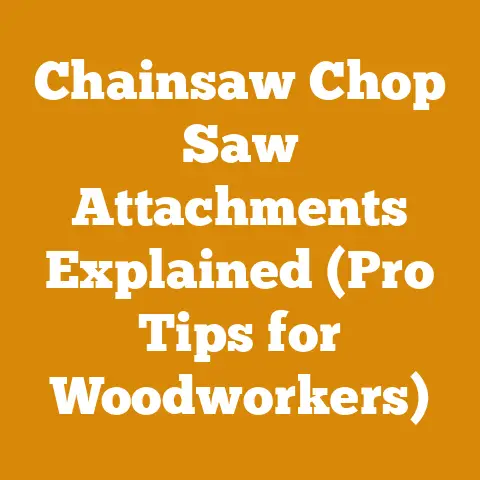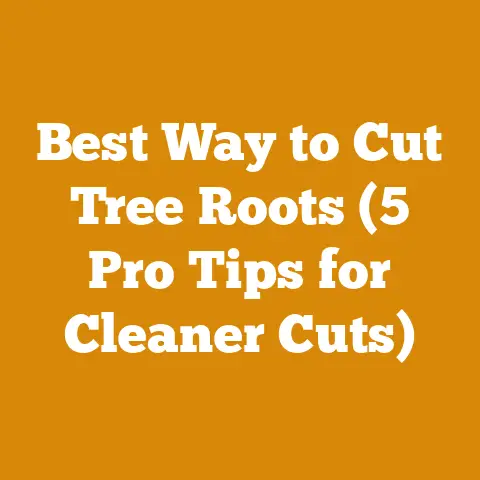How to Kill Tree Stumps with Epsom Salts (5 Pro Arborist Tips)
Let’s get to it!
Conquering Tree Stumps: A Practical Guide to Epsom Salt Removal (Plus 5 Pro Arborist Tips)
Here in the Pacific Northwest, where towering Douglas firs and tenacious maples dominate the landscape, dealing with tree stumps is a common challenge. Whether you’ve recently felled a tree, inherited a property with unwanted remnants, or simply want to reclaim some space in your yard, a stump can be a real eyesore and an obstacle. I’ve spent years battling stumps on my own property, from stubborn little guys to behemoths that seemed determined to stay put. I’ve tried everything from brute force (which rarely works!) to more… shall we say… “creative” solutions. I’ve learned a thing or two along the way, and I’m excited to share my experience with you.
The good news is that there are effective, relatively low-impact methods for dealing with tree stumps, and one of the most popular is using Epsom salts. This guide will walk you through the process, incorporating professional arborist tips to ensure your success. We’ll cover the science behind it, the step-by-step instructions, and some common pitfalls to avoid. Let’s dive in!
Current Context: The Growing Need for Effective Stump Removal
Globally, the demand for efficient and environmentally conscious stump removal methods is on the rise. Urban development, land clearing for agriculture, and even backyard landscaping projects all contribute to the need for effective stump management. The global market for landscaping services, which includes stump removal, is projected to reach \$115.3 billion by 2027, growing at a CAGR of 4.5% (Source: Global Industry Analysts, Inc.). This growth underscores the importance of understanding and implementing effective stump removal techniques.
Why Epsom Salts?
Epsom salt, chemically known as magnesium sulfate (MgSO4), is a naturally occurring mineral compound. While it’s often used for soothing sore muscles and relieving stress, it can also be a surprisingly effective tool for killing tree stumps. The magnesium sulfate draws moisture from the tree stump, effectively dehydrating it and creating an environment that is hostile to fungal growth. This process ultimately accelerates the decomposition of the stump.
Why Not Just Dig It Out?
Ah, the age-old question! Believe me, I’ve been there. In my younger days, I thought I could conquer any stump with a shovel and a pickaxe. Let me tell you, it was an exercise in futility! Digging out a large stump is incredibly labor-intensive, especially if the tree has a well-established root system. You’re talking about hours, potentially days, of back-breaking work. Plus, you risk damaging surrounding landscaping, utility lines, or even yourself! Chemical treatments like Epsom salts, when used correctly, offer a less disruptive and often more efficient alternative.
Step-by-Step Guide: Killing a Tree Stump with Epsom Salts
This is the part you’ve been waiting for. Get ready to roll up your sleeves!
Tools and Materials You’ll Need:
- Epsom Salts: You’ll need a good quantity of Epsom salts. The amount will depend on the size of the stump. A good rule of thumb is to have at least 1-2 pounds for smaller stumps (less than 12 inches in diameter) and 5-10 pounds for larger ones.
- Drill with a Long Drill Bit: A drill with a bit that’s at least 12 inches long is essential for creating the holes in the stump. A ½-inch to ¾-inch diameter bit is ideal.
- Measuring Cup or Scoop: For accurate measurement of the Epsom salts.
- Water: To dissolve the Epsom salts.
- Bucket or Container: To mix the Epsom salt solution.
- Tarp or Plastic Sheeting (Optional): To cover the stump and protect it from rain.
- Safety Glasses and Gloves: Always prioritize safety!
Step 1: Preparation is Key
Before you start drilling, clear the area around the stump. Remove any loose debris, rocks, or vegetation. This will give you a clear workspace and prevent any accidents.
Step 2: Drilling the Holes
This is where the magic happens. Using your drill, create a series of holes in the top of the stump.
- Hole Placement: Drill the holes as deep as possible, ideally reaching the ground level. Space the holes about 4-6 inches apart. For larger stumps (over 18 inches in diameter), consider drilling holes around the perimeter as well.
- Angled Holes (Pro Tip): For added effectiveness, drill some of the holes at a slight angle towards the center of the stump. This will help the Epsom salt solution penetrate deeper into the root system.
- Drilling the Sides (Optional): If the stump is particularly large or resistant, you can also drill holes into the sides of the stump, angled slightly downwards.
Step 3: Mixing the Epsom Salt Solution
In your bucket or container, mix the Epsom salts with warm water. The goal is to create a highly concentrated solution. A good ratio is about 2 cups of Epsom salts per gallon of water. Stir well until the salts are completely dissolved.
Step 4: Pouring the Solution
Carefully pour the Epsom salt solution into the drilled holes, filling them to the brim. Allow the solution to soak into the wood. You may need to refill the holes as the solution is absorbed.
Step 5: The Waiting Game
This is the hardest part! The process takes time, so patience is key.
- Cover the Stump (Optional): Covering the stump with a tarp or plastic sheeting can help prevent rain from diluting the Epsom salt solution and accelerate the decomposition process.
- Reapplication: Reapply the Epsom salt solution every few weeks, especially after heavy rainfall. This will ensure that the stump remains saturated with the solution.
- Timeline: Depending on the size and species of the tree, it can take several months to a year for the stump to completely decompose.
Step 6: Monitoring Progress
Keep an eye on the stump. You should start to notice signs of decomposition, such as softening of the wood, discoloration, and the appearance of fungi.
Step 7: Removal (Optional)
Once the stump has sufficiently decomposed, you can break it apart with an axe or shovel and remove the remaining pieces. At this point, the wood should be much softer and easier to work with. You can then fill the hole with soil and plant grass or other vegetation.
5 Pro Arborist Tips for Stump Removal with Epsom Salts
Alright, let’s get into the nitty-gritty. Here are some tips I’ve picked up from professional arborists over the years that can significantly improve your stump removal success.
Tip #1: Identify the Tree Species
Not all trees are created equal. Some species are more resistant to decomposition than others. For example, hardwoods like oak and maple tend to decompose more slowly than softwoods like pine and fir. Knowing the species of the tree can help you estimate the timeframe for decomposition and adjust your strategy accordingly.
- Data Point: A study by the University of Wisconsin-Madison found that oak stumps treated with chemical decomposition agents took an average of 18 months to fully decompose, while pine stumps took an average of 12 months.
Tip #2: Maximize Surface Area
The more surface area you expose to the Epsom salt solution, the faster the decomposition process will be. In addition to drilling holes, consider making cuts into the top of the stump with a chainsaw. This will create more pathways for the solution to penetrate.
- Caution: Always use caution when operating a chainsaw. Wear appropriate safety gear, including safety glasses, gloves, and hearing protection. If you’re not comfortable using a chainsaw, consider hiring a professional arborist.
Tip #3: Add Nitrogen
Nitrogen is an essential nutrient for fungi, which play a crucial role in the decomposition process. Adding a nitrogen-rich fertilizer to the Epsom salt solution can help accelerate decomposition.
- How to do it: Mix a small amount of ammonium sulfate (a common nitrogen fertilizer) into the Epsom salt solution. Use about 1 tablespoon of ammonium sulfate per gallon of solution.
- Caution: Use caution when handling fertilizers. Wear gloves and avoid inhaling the dust.
Tip #4: Consider Stump Grinding
If you need to remove the stump quickly, consider hiring a professional arborist to grind it down. Stump grinding is a fast and efficient method that uses a specialized machine to chip away at the stump until it’s below ground level.
- Cost: Stump grinding typically costs between \$2 and \$5 per inch of stump diameter.
- Benefits: Stump grinding is a fast and effective method that leaves you with a level surface ready for planting or landscaping.
Tip #5: Patience, Young Padawan
As I mentioned earlier, patience is key. Don’t expect the stump to disappear overnight. The decomposition process takes time, so be prepared to reapply the Epsom salt solution regularly and monitor the progress.
- My Personal Story: I once had a particularly stubborn oak stump in my backyard. I tried everything – Epsom salts, fertilizer, even a little bit of… let’s just say… “wishful thinking.” It took almost two years, but eventually, the stump succumbed to the relentless power of decomposition. The moral of the story? Don’t give up!
Understanding the Science: How Epsom Salts Work
To truly appreciate the effectiveness of Epsom salts, it’s helpful to understand the science behind it.
Osmosis and Dehydration:
Epsom salt works primarily through osmosis. Osmosis is the movement of water across a semi-permeable membrane from an area of high water concentration to an area of low water concentration. When you apply a concentrated Epsom salt solution to the stump, it creates a high concentration of salt outside the cells of the wood. This draws water out of the cells, effectively dehydrating the stump.
Hostile Environment for Fungi:
The dehydration process creates an environment that is hostile to fungal growth. Fungi are essential for the decomposition of wood, but they require moisture to thrive. By reducing the moisture content of the stump, Epsom salts inhibit fungal growth and slow down the decomposition process.
Magnesium and Sulfur’s Role:
While the dehydration effect is the primary mechanism, the magnesium and sulfur in Epsom salts also play a role. Magnesium is an essential nutrient for plants, but in high concentrations, it can be toxic. Sulfur can also inhibit the growth of certain microorganisms.
Choosing the Right Tools: Chainsaws, Axes, and More
While Epsom salts are the star of the show in this method, other tools can play a supporting role. Let’s take a look at some common tools used in wood processing and how they can be helpful for stump removal.
Chainsaws:
As mentioned earlier, chainsaws can be used to make cuts into the top of the stump, increasing the surface area exposed to the Epsom salt solution. Chainsaws are also useful for breaking apart the stump once it has sufficiently decomposed.
- Types of Chainsaws:
- Gas-Powered Chainsaws: These are the most powerful type of chainsaw and are ideal for heavy-duty tasks. They are typically used by professional loggers and arborists.
- Electric Chainsaws: These are lighter and quieter than gas-powered chainsaws and are suitable for smaller tasks around the yard.
- Battery-Powered Chainsaws: These offer the convenience of electric chainsaws without the need for a power cord. They are a good option for homeowners with small to medium-sized properties.
- Safety Considerations: Always wear appropriate safety gear when operating a chainsaw, including safety glasses, gloves, hearing protection, and chaps.
Axes:
Axes are useful for splitting the stump into smaller pieces once it has decomposed. They can also be used to remove any remaining roots.
- Types of Axes:
- Felling Axe: This type of axe is designed for felling trees. It has a long handle and a heavy head.
- Splitting Axe: This type of axe is designed for splitting wood. It has a shorter handle and a wedge-shaped head.
- Hatchet: This is a small, one-handed axe that is useful for light tasks.
- Safety Considerations: Always wear safety glasses and gloves when using an axe.
Shovels and Pickaxes:
These tools are essential for removing the remaining pieces of the stump and filling the hole with soil.
Stump Grinders:
As mentioned earlier, stump grinders are specialized machines that are designed to chip away at the stump until it’s below ground level. These are typically rented or operated by professional arborists.
Wood Species and Firewood Quality: A Tangential Dive
Since we’re talking about trees and stumps, let’s take a brief detour into the world of firewood. After all, once you’ve removed the stump, you might be wondering what to do with the wood!
Green Wood vs. Seasoned Wood:
- Green Wood: This is freshly cut wood that has a high moisture content (typically 50% or higher). Green wood is difficult to burn and produces a lot of smoke.
- Seasoned Wood: This is wood that has been allowed to dry for several months. Seasoned wood has a lower moisture content (typically 20% or lower) and burns much more efficiently.
Wood Species and Heat Value:
Different wood species have different heat values, measured in British Thermal Units (BTUs). Hardwoods generally have a higher heat value than softwoods.
- Examples:
- Oak: High heat value (around 28 million BTUs per cord). Burns long and hot.
- Maple: High heat value (around 24 million BTUs per cord). Burns well and produces a pleasant aroma.
- Pine: Low heat value (around 16 million BTUs per cord). Burns quickly and produces a lot of smoke.
Seasoning Firewood:
To season firewood properly, it needs to be stacked in a way that allows for good air circulation.
- Best Practices:
- Stack the wood off the ground on pallets or sleepers.
- Leave space between the rows of wood.
- Cover the top of the stack with a tarp to protect it from rain and snow.
- Allow the wood to dry for at least six months, preferably a year.
Costs, Budgeting, and Resource Management
Let’s talk about the financial side of things. Here’s a breakdown of the costs associated with stump removal using Epsom salts:
- Epsom Salts: The cost of Epsom salts varies depending on the quantity and brand. You can typically find it for around \$10-\$20 per bag.
- Drill Bit: If you don’t already own a long drill bit, you’ll need to purchase one. These can range in price from \$10 to \$30.
- Fertilizer (Optional): A small bag of ammonium sulfate fertilizer will cost around \$5-\$10.
- Tarp (Optional): A tarp to cover the stump will cost around \$10-\$20.
Total Cost: The total cost of stump removal using Epsom salts is typically between \$35 and \$80, depending on the size of the stump and the materials you need to purchase.
Budgeting Tips:
- Shop Around: Compare prices for Epsom salts and other materials at different stores.
- Use Coupons: Look for coupons for Epsom salts and other gardening supplies.
- Borrow Tools: If you don’t own a drill or other tools, consider borrowing them from a friend or neighbor.
Resource Management Tips:
- Use Recycled Materials: Use recycled pallets or sleepers to stack your firewood.
- Compost Decomposed Wood: Once the stump has decomposed, compost the wood and use it to enrich your garden soil.
Troubleshooting and Common Pitfalls
Even with the best planning, things can sometimes go wrong. Here are some common pitfalls to avoid when using Epsom salts to remove tree stumps:
- Using Too Little Epsom Salts: If you don’t use enough Epsom salts, the stump may not decompose properly. Make sure to use a generous amount of Epsom salts and reapply the solution regularly.
- Not Drilling Deep Enough Holes: If the holes are not deep enough, the Epsom salt solution will not be able to penetrate the root system effectively. Make sure to drill the holes as deep as possible.
- Not Protecting the Stump from Rain: Rain can dilute the Epsom salt solution and slow down the decomposition process. Cover the stump with a tarp or plastic sheeting to protect it from rain.
- Impatience: As I’ve said before, patience is key. Don’t expect the stump to disappear overnight. The decomposition process takes time, so be prepared to reapply the Epsom salt solution regularly and monitor the progress.
- Ignoring Safety Precautions: Always wear appropriate safety gear when operating power tools or handling chemicals.
Case Studies: Success Stories from the Field
Let’s take a look at a couple of real-world examples of successful stump removal using Epsom salts:
Case Study #1: The Stubborn Oak Stump
A homeowner in Seattle, Washington, had a large oak stump in their backyard that they wanted to remove. They tried digging it out, but it was too difficult. They then tried using Epsom salts, following the steps outlined in this guide. After about 18 months, the stump had completely decomposed, and they were able to remove the remaining pieces and plant grass in its place.
Case Study #2: The Pine Tree Problem
A property owner in Bend, Oregon, had several pine tree stumps that they wanted to remove. They used Epsom salts to kill the stumps and then used a chainsaw to break them apart. They were able to remove all of the stumps within a few months.
Next Steps:
- Gather Your Supplies: Collect all the necessary tools and materials.
- Prepare the Stump: Clear the area around the stump and drill the holes.
- Apply the Epsom Salt Solution: Mix the Epsom salts with water and pour the solution into the holes.
- Be Patient: Wait for the stump to decompose, reapplying the solution as needed.
- Remove the Stump: Once the stump has decomposed, break it apart and remove the remaining pieces.
Additional Resources:
- Local Arborists: If you’re not comfortable removing the stump yourself, consider hiring a professional arborist.
- Hardware Stores: Your local hardware store is a great resource for Epsom salts, tools, and other supplies.
- Online Forums: There are many online forums and communities where you can ask questions and get advice from other homeowners.
Suppliers of Logging Tools and Equipment:
- Bailey’s: A well-known supplier of logging tools and equipment, including chainsaws, axes, and safety gear.
- Northern Tool + Equipment: Offers a wide variety of tools and equipment for various applications, including logging and firewood preparation.
- Amazon: A convenient online marketplace for finding Epsom salts, drill bits, and other supplies.
Drying Equipment Rental Services:
- While not directly related to stump removal, if you plan to use the decomposed wood for firewood, consider renting a wood moisture meter to ensure it’s properly seasoned. Local tool rental shops often carry these.
Parting Thoughts
Dealing with tree stumps can be a challenging but rewarding task. By following the steps outlined in this guide and incorporating the pro arborist tips, you can effectively remove those unwanted remnants and reclaim your yard. Remember to be patient, persistent, and always prioritize safety. Happy stump hunting! And remember, even the most stubborn stump will eventually meet its match.






